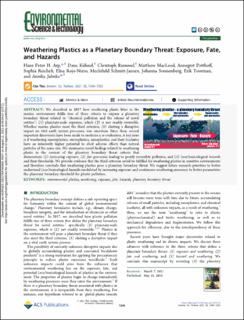| dc.contributor.author | Arp, Hans Peter | |
| dc.contributor.author | Kühnel, Dana | |
| dc.contributor.author | Rummel, Christoph | |
| dc.contributor.author | MacLeod, Matthew | |
| dc.contributor.author | Potthoff, Annegret | |
| dc.contributor.author | Reichelt, Sophia | |
| dc.contributor.author | Rojo-Nieto, Elisa | |
| dc.contributor.author | Schmitt-Jansen, Mechthild | |
| dc.contributor.author | Sonnenberg, Johanna | |
| dc.contributor.author | Toorman, Erik | |
| dc.contributor.author | Jahnke, Annika | |
| dc.date.accessioned | 2022-02-14T09:14:08Z | |
| dc.date.available | 2022-02-14T09:14:08Z | |
| dc.date.created | 2021-08-05T15:04:28Z | |
| dc.date.issued | 2021 | |
| dc.identifier.citation | Environmental Science and Technology. 2021, 55 (11), 7246-7255. | en_US |
| dc.identifier.issn | 0013-936X | |
| dc.identifier.uri | https://hdl.handle.net/11250/2978642 | |
| dc.description.abstract | We described in 2017 how weathering plastic litter in the marine environment fulfils two of three criteria to impose a planetary boundary threat related to “chemical pollution and the release of novel entities”: (1) planetary-scale exposure, which (2) is not readily reversible. Whether marine plastics meet the third criterion, (3) eliciting a disruptive impact on vital earth system processes, was uncertain. Since then, several important discoveries have been made to motivate a re-evaluation. A key issue is if weathering macroplastics, microplastics, nanoplastics, and their leachates have an inherently higher potential to elicit adverse effects than natural particles of the same size. We summarize novel findings related to weathering plastic in the context of the planetary boundary threat criteria that demonstrate (1) increasing exposure, (2) fate processes leading to poorly reversible pollution, and (3) (eco)toxicological hazards and their thresholds. We provide evidence that the third criterion could be fulfilled for weathering plastics in sensitive environments and therefore conclude that weathering plastics pose a planetary boundary threat. We suggest future research priorities to better understand (eco)toxicological hazards modulated by increasing exposure and continuous weathering processes, to better parametrize the planetary boundary threshold for plastic pollution. | en_US |
| dc.language.iso | eng | en_US |
| dc.publisher | American Chemical Society | en_US |
| dc.rights | Attribution-NonCommercial-NoDerivatives 4.0 Internasjonal | * |
| dc.rights.uri | http://creativecommons.org/licenses/by-nc-nd/4.0/deed.no | * |
| dc.title | Weathering Plastics as a Planetary Boundary Threat: Exposure, Fate, and Hazards | en_US |
| dc.type | Peer reviewed | en_US |
| dc.type | Journal article | en_US |
| dc.description.version | publishedVersion | en_US |
| dc.source.pagenumber | 7246-7255 | en_US |
| dc.source.volume | 55 | en_US |
| dc.source.journal | Environmental Science and Technology | en_US |
| dc.source.issue | 11 | en_US |
| dc.identifier.doi | 10.1021/acs.est.1c01512 | |
| dc.identifier.cristin | 1924189 | |
| cristin.ispublished | true | |
| cristin.fulltext | original | |
| cristin.qualitycode | 2 | |

